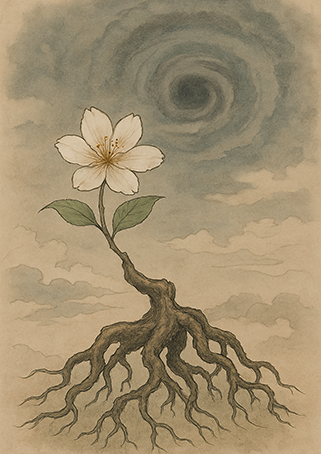Xieyi・The Rootless Tree:24 Chapters-Appendix I#360

The poems of “The Rootless Tree” express a fundamental force rooted in harmony with heaven and earth, the cyclical flow of yin and yang, and the infinite potential of existence。
This painting is an expressive “Xieyi” in the tradition of “futu” (spiritual diagrams), passed down for generations in Wudang Mountain, China. It is drawn through a technique where energy flow (xingqi) channels the internal intention into visual form。 In the Taoist world, there exist spiritual and symbolic images called “futu”。
In the Taoist world, there exist spiritual and symbolic images called “futu”。
These are a type of talisman—not merely religious items, but expressive spiritual paintings that act directly on the mind of the viewer。
Since ancient times, many people have placed these Taoist-style “Xieyi” and futu in their homes, studies, or bedrooms, wishing for longevity, health, auspiciousness, and family harmony. Viewing such paintings was not just aesthetic appreciation, but an act of inviting the presence of the Dao into one’s life and tuning the body and mind。
Thus, “Xieyi” is more than artistic expression—it is a medium that bridges the spirit, life, and harmony with the universe。
This kind of artwork is not meant to be seen only with the eyes, but felt with the heart。
It communicates with the Dao, resonates with the qi of nature, and quietly stirs the viewer’s inner self。
Futu and “Xieyi” continue to live on from ancient times to this day as “sacred images that speak to the soul.”
Below, we present the original text of the philosophical poem “The Rootless Tree,” along with a modern Japanese translation and interpretation。
※ The author of “The Rootless Tree,” Zhang Sanfeng (1247–?), is also renowned as the founder of Tai Chi, and it is said that he applied the essence of this work to Tai Chi. As an additional note, we include an interpretation connecting this to the Tai Chi tradition of Wudang Mountain.
The Rootless Tree・Appendix I

▶Original Text
無根樹,花正殊,根在坤維接太虛。三家路,會玄珠,牢把金鎖鎮玄都。
吞盡靈砂歸鼎內,神虎驤騰走鬼區。喜踟躕,笑踟躕,行到蓬萊觀碧虛。
▶Modern Translation
The flower of the rootless tree is unlike any other; its root lies in Earth (Kun) and connects with the Infinite Void.
The three paths unite in the Pearl of Mystery. Grasp the golden key and stabilize the Sacred Capital.
Swallow all spiritual sand and return it to the cauldron. The Divine Tiger leaps through ghostly realms.
With joy and hesitation, one finally arrives at Penglai, gazing into the blue sky.
▶Interpretation
• Symbolizes the unification of the Daoist, Confucian, and Buddhist paths.
• The journey ends in spiritual freedom and vision.▶Interpretation related to Tai Chi
Tai Chi, too, integrates diverse philosophies into one way.
This poem describes transcending inner fears and outer limitations—reaching effortless mastery.
Copyright © MASAKI WAKABAYASHI. All rights reserved.




